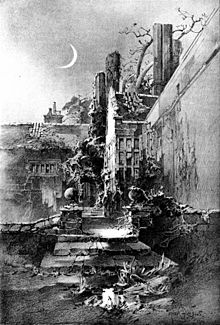Folklore

Hobgoblins seem to be small, hairy little men who, like their close relatives the brownies, are often found within human dwellings, doing odd jobs around the house while the family is asleep. Such chores are typically small tasks like dusting and ironing. Often, the only compensation necessary in return for these is food.
While brownies are more peaceful creatures, hobgoblins are more fond of practical jokes. They also seem to be able to shapeshift, as seen in one of Puck's monologues in A Midsummer Night's Dream. Robin Goodfellow is perhaps the most mischievous and most infamous of all his kind, but many are less antagonizing. Like other fairy folk, hobgoblins are easily annoyed. They can be mischievous, frightening, and even dangerous.[1](p100) Attempts to give them clothing will often banish them forever, though whether they are offended by such gifts or are simply too proud to work in new clothes differs from teller to teller.
- Billy Blind
- is a clever hobgoblin or brownie found in several ballads collected by F.J. Child. Billy Blind helps humans in dramatic situations by offering valuable information and advice.[4][5][6][7]
- Blue Burches
- is the name of a shapeshifting hobgoblin who played harmless pranks in the home of a shoemaker and his family on the Blackdown Hills in Somerset. His usual form was that of an old man wearing baggy blue breeches but he also took the form of a white horse, a black pig and a wisp of blue smoke. The family took his presence in good stride but some clergymen learned of his existence and banished him from the house.[1](p27)
- Robin Roundcap
- (not to be confused with Robin Redcap) haunted Spaldington Hall in Spaldington, East Riding of Yorkshire and was a hearth spirit of the true hobgoblin type. He helped thresh the corn and performed other domestic chores, but when he was in the mood for mischief he would mix the wheat and chaff again, kick over the milk pail, and extinguish the fire. He is said to have been confined in a well for a stipulated number of years through the prayers of three clergymen. This well is known as Robin Roundcap's Well.[8]
- Dobby
- is another term for hobgoblin in Lancashire and Yorkshire according to the folklorist Elizabeth Mary Wright, especially one that is a relentless prankster. Much like the boggart, a dobby's pranks may become so troublesome that a family decides to move elsewhere, only to find that the dobby has followed them (one version of this tale involves Robin Roundcap). However, one Yorkshire dobby (or hob) lived in a cave and was noted for curing children of the whooping cough. Dobbies could be just as industrious as other hobgoblins and brownies, which led to the expression "Master Dobbs has been helping you" whenever a person has accomplished more work than was expected.[9] The term is also referenced in the character of the house-elf Dobby in the Harry Potter series.